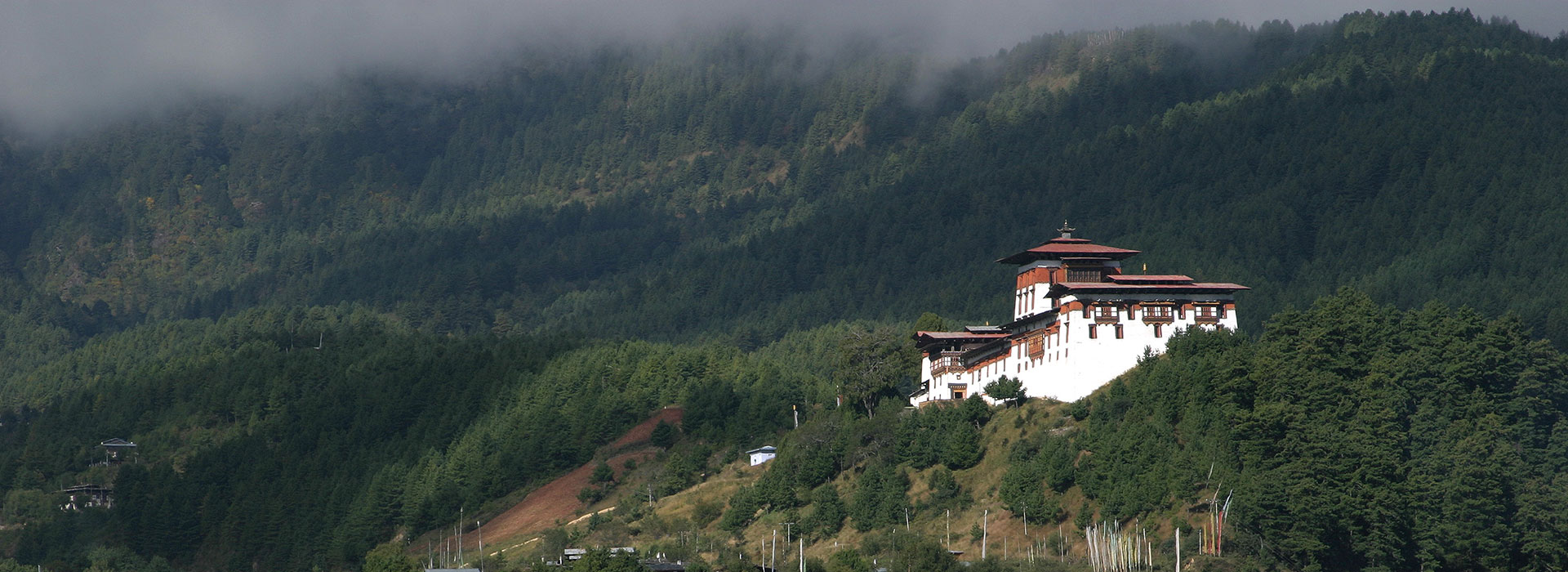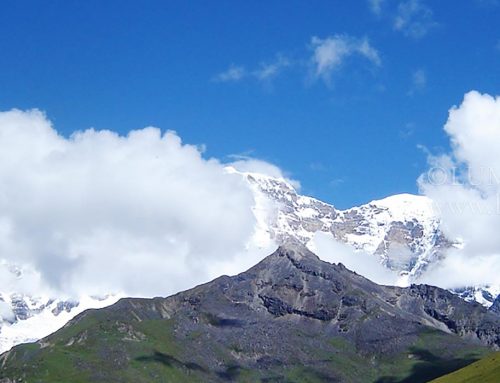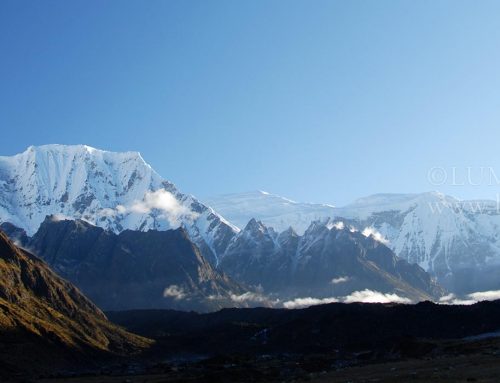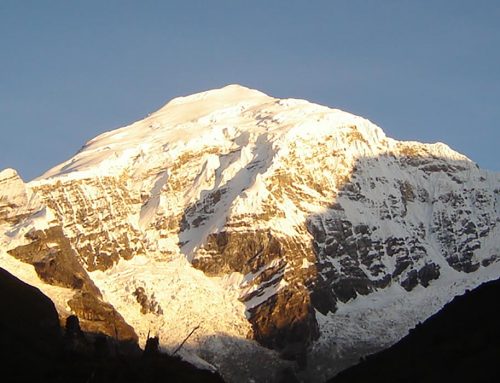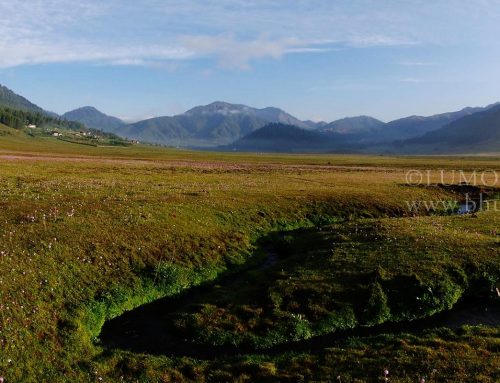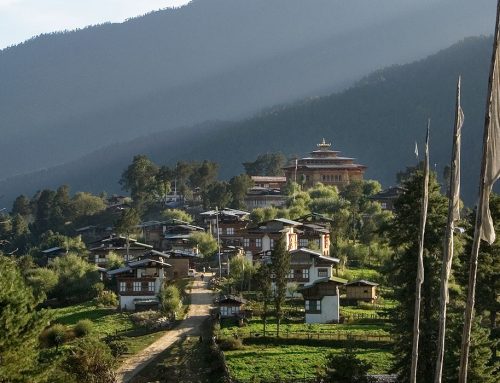- Duration: 15 nights / 16 days.
- Accommodation: Hotels, Resorts and Tents.
- Activity Type: Walking, Trekking & Tour.
- Difficulty Level: Strenuous.
- Highest Point: 4700 meters
- Trek Duration: 8 Days
- Group size: Minimum 2 pax
- Best Months for the Trek: March – May, September – November.
- Memorable hot spring bath in the wooden bath tub.
- Visit to the tallest Statue of Buddha in Bhutan.
- Visit to the National Memorial Chorten, Punakha Dzong, Chimi Lhakhang (Temple of Fertility), Drukgyal Dzong (Victory Fortress), Trongsa Dzong, Kichu Monastery (built in the Seventh Century), Tamshing Lhakhang, Jambay lhakhang, Kurjey Lhakhang, and Jakar Dzong.
- A Panoramic view of the higher himalayas from the Dochu La Pass (3140m).
- Excursion to the famous Taktsang Monastery (The Tiger’s Nest).
- Visit to Membartsho (The Burning Lake).
DAY 01. ARRIVE AT PARO, 2280 METERS, BY DRUK AIR:
The flight into Paro is a befitting introduction to the spectacular beauty of Bhutan. In clear weather, you will be able to see some of the world’s highest peaks as you fly into Paro. As the aircraft prepares for landing, you will be surrounded by the lush green valleys. On landing, your Bhutanese escort from Druk & Drukpa Travel will greet you at the exit terminal, and then drive you the short distance to the hotel. After lunch you will visit the Ta-dzong [museum]. Overnight at a hotel.
DAY 02. PARO SIGHTSEEING 2280 METERS:
After breakfast, we will drive you to the ruins of the Drukgyal Dzong (Victory Fortress) about 16 km away from Paro town. Built in 1647 by the great Shabdrung Ngawang Namgyel, father and unifier of medieval Bhutan, the dzong was destroyed by fire and has been in ruins since then – an evocative reminder of the great victories it was built to commemorate. On a clear day you will see an unforgettable view of Mt. Jhomolhari (7,314 m), the highest unclimbed peak in the world. On the way back you will visit a typical Bhutanese farmhouse. In the afternoon, an excursion to Taktsang monastery and on the way back, visit Kichu Lhakhang, built in 659 A.D by the Tibetan king Srongsen Gampo. Overnight in a hotel.
DAY 03. PARO – THIMPHU, 2320 METER:
We will follow the winding road by the Pachu River downstream to its confluence with the Wangchu, then drive on to Thimphu, the capital. Lunch at a hotel. After lunch, we will visit the Memorial Chorten. Overnight in a hotel.
DAY 04. THIMPHU – PUNAKHA, 1310 METERS:
After breakfast, you will be driven to Punakha via Dochula Pass. If the weather is clear, we stop for a while at Dochula to view the higher Himalayas. Lunch at Punakha. After lunch, we will visit Punakha Dzong built in 1637 by Zhabdrung Ngawang Namgyal and located between Pho Chu (Male River) and Mo Chu (Female River). There was a smaller building here called Dzong Chu (Small Dzong) that housed a statue of Buddha. It is said that Zhabdrung ordered the architect, Zowe Palep, to sleep in front of the statue, and while Palep was sleeping the Zhabdrung took him in his dreams to Zangtopelri and showed him the palace of Guru Rimpoche. From his vision, the architect conceived the design for the new Dzong, which in keeping with the tradition, was never committed to paper. The Dzong was named Druk Pungthang Dechen Phodrang (Palace of Great Happiness). Punakha is still the winter residence of Je Khenpo, the Lama of Bhutan. Overnight in a hotel.
DAY 05. PUNAKHA – TRONGSA – BUMTHANG 2800 METERS:
We start early, driving to Bumthang after breakfast. On the way, we will stop a while to view the Chime Lhakhang, which was built by Lama Drukpa Kuenley, also known as the Divine Madman. The Temple is also known as “the Temple of Fertility”. You will also see Wangduephodrang Dzong (from outside) built in 1638. The Dzong is situated at the confluence of Mo Chu and Tang Chu rivers. Lunch at Trongsa. After lunch, we will visit Trongsa Dzong, the most impressive dzong in Bhutan, built in its present form in 1644 by Chogyal Minjur Tempa, the official who was sent by Zhabdrung to unify eastern Bhutan. It was later expanded at the end of the 17th century by Desi Tenzin Rabgay. Trongsa Dzong is the ancestral home of the present Royal Family and first two hereditary kings ruled Bhutan from this Dzong. We will then visit Ta Dzong, an ancient watch tower, now the Monarchy Museum. The chapel inside the Ta Dzong is said to be dedicated to the Trongsa Penlop Jigme Namgyal. We arrive in Bumthang in the evening. Overnight in a hotel.
DAY 06. BUMTHANG SIGHTSEEING, 2800 METERS:
After breakfast, you will visit Jakar Dzong, which literally means “The Castle of White Bird”. Then we will visit Jambay Lhakhang, built by King Srongsen Gampo of Tibet in the year 659 on the same day as Kichu Lhakhang in Paro. The temple was visited by Guru Rimpoche during his visit to Bumthang and was renovated by Sindhu Raja after Guru Rimpoche restored his life force. Under the temple is said to be a lake in which Guru Rimpoche hid several Terma. In October, one of the most spectacular festivals, “Jambay Lhakhang Drup” is staged here. After lunch we visit Kurjey Lhakhang that is named after the body print of Guru Rinpoche, built in 1652 by Minjur Tempa. Then we will visit Tamshing Lhakhang, established in 1501 by Pema Lingpa and is the most important Nyingmapa temple in the kingdom.
DAY 07. BUMTHANG – GORSUM:
After breakfast, the bus will reach you up to the trek point just below Kurje Lhakhang. The trek route leads you along the Chamkhar Chu, a river known for its richness in Trout. The trek trail for Bumthang to Gorsum is rather gradual. Overnight in a camp.
Altitude 3120 meters; Distance 18 km; Time about 6 – 7 hours.
DAY 08. GORSUM – LUNGSUM:
You trek through dense forest of spruce, hemlock, cypress, juniper and maple. The trail is more or less muddy and ascends gradually till you reach your campsite. Overnight in a camp.
Altitude 3160 meters; Distance 12 km; Time about 5 hrs.
DAY 09. LUNGSUM – TSHOCHENCHEN:
The vegetation is dense from Tshochenchen all the way up hill to Julila Pass, which is about 4700 m. The vegetation from Lungsum to Tshochenchen is more or less the same till you reach near your campsite. The camp will be above tree line. Overnight in a camp.
Altitude 3100 m; Distance 15 km; Time 6-7 hrs.
DAY 10. TSHOCHENCHEN – DUR TSHACHU:
The trek from Tshochenchen is uphill till you reach the Julila Pass at about 3400 m. From here if the weather is clear, surrounding mountains can be viewed. After crossing the pass, the trek trail descends till you reach the campsite. Musk deer, herds of Blue sheep and Himalayan Beers may be seen en route. Overnight in a camp.
Altitude 3400 m; Distance 17 km; Time about 7 hrs.
DAY 11. DUR TSACHU (HALT):
After a late breakfast, relax in the hot spring or hike in and around the camp. Overnight in a camp.
DAY 12. DUR TSACHU – TSHOCHENCHEN:
The trek trail from Dur Tsachu is uphill till Julila Pass. After crossing the pass, the trail descends till you reach the campsite. Overnight in a camp.
Altitude 3100 m; Distance 17 km; Time about 7 hrs.
DAY 13. TSHOCHENCHEN – GORSUM:
The trek begins early, as the trail is long. The trail drops gradually down for about 2 hrs till you reach the campsite. Overnight in a camp.
Altitude 3120 m; Distance 17 km; Time about 9 hrs.
DAY 14. GORSUM – BUMTHANG:
From Gorsum, you will descend downhill till you cross the Dur Village bridge then follow the new motor road till you meet up with the awaiting transport. After lunch, leisure time. Overnight at a lodge.
DAY 15. BUMTHANG – THIMPHU:
After breakfast, drive to Thimphu (7 ½ hrs.).
DAY 16. DEPARTURE:
- Mountain biking in Thimphu.
- Hike to Dzongdrakha.
- Hike to Chelela pass.
- Hike to Tango/Cheri Monastery.
- Visit to a Bhutanese Farm House.
- Rafting in Pho Chu (Punakha).
- Hike to Tharpaling Monastery.
- Excursion to Ura/Shingkhar village.
- Bhutanese Cultural show.
Cost inclusive of:
- All Meals [Breakfast /Lunch/Dinner]
- Accommodation [Twin Sharing] Single Room Supplement Extra US $: 40 per room per night.
- All transportation within the country including airport transfers.
- Royalty & Govt. Taxes
- Entrance fees for Museums and Monuments only
- Visa Fee
- Airport tax
- Contribution to Tourism Development Fund
- Guide
- Sightseeing
While on trek, cost covers:
- Nature Recreation and Ecotourism Division (NRED) Nu.1000
- 3 meals a day
- Service of cook & helper
- Guide, sleeping tent
- Mess Tent, Kitchen Tent & Toilet Tent
- Ponies to carry supplies
- Royalty
- We will provide you with sleeping mats but you have to bring your own sleeping bags.
Cost exclusive of:
- Druk Air fare
- Insurance Premiums
- Payments for service provided on a personal basis
- Cost for any services not mentioned in the “Cost Include Head”
- Cost incurred due to mishaps, strikes, political unrest, etc.
- Personal expense in items such as laundry, soft drinks, camera charges, bottled water, incidentals, portage, bellboy charges, tips or any other services
Personal clothing: strong normal clothing (according to season). Preferably cotton, even for summer, woolen clothing for the evening and winter.
For Trekking, one must bring:
- Strong comfortable trekking boots – water-resistant for the rainy period of June-August
- Sunscreen
- Flash light
- Rain coat (especially for rainy period – June-August)
- Head gear/hat/cap for sun and rain protection
- Water pills – for extra caution in purifying stream; (boiled water is provided at all times during the trek)
- Aspirin – incase of altitude sickness
- Lots of socks
- Warm clothes
OPTIONAL ITEMS
- Sunglasses
- Headgear
- Folding umbrella (only for wet months — July and August)
- One towel
- Pillow case
- Wet-packed tissue paper
- Pillow


